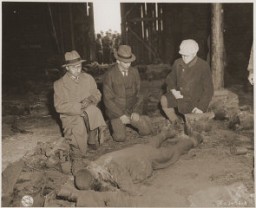
Photo
Browse an alphabetical list of photographs. These historical images portray people, places, and events before, during, and after World War II and the Holocaust.
<< Previous | Displaying results 81-90 of 140 for "Photo" | Next >>
-
Thomas Buergenthal with one of his grandchildren
PhotoThomas with Eliza, one of his grandchildren. 1996. With the end of World War II and collapse of the Nazi regime, survivors of the Holocaust faced the daunting task of rebuilding their lives. With little in the way of financial resources and few, if any, surviving family members, most eventually emigrated from Europe to start their lives again. Between 1945 and 1952, more than 80,000 Holocaust survivors immigrated to the United States. Thomas was one of them.
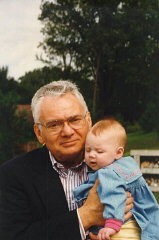
-
Thomas Buergenthal with the soldier who realized that Thomas was Jewish and took him to an orphanage
PhotoThomas (left), 6 months after liberation, with a soldier who realized that Thomas was Jewish and took him to an orphanage, ca. 1945. Thomas was eventually reunited with his mother. With the end of World War II and collapse of the Nazi regime, survivors of the Holocaust faced the daunting task of rebuilding their lives. With little in the way of financial resources and few, if any, surviving family members, most eventually emigrated from Europe to start their lives again. Between 1945 and 1952, more than…

-
Thomas in his toy car
PhotoPhotograph of a young Thomas Buergenthal posing in his toy car as his mother sits alongside. 1936.

-
Thomas with his mother, Gerda, before Thomas's departure for the United States
PhotoThomas Buergenthal with his mother, Gerda, before Thomas's departure for the United States. Bad Neuheim, Germany, summer 1951. With the end of World War II and collapse of the Nazi regime, survivors of the Holocaust faced the daunting task of rebuilding their lives. With little in the way of financial resources and few, if any, surviving family members, most eventually emigrated from Europe to start their lives again. Between 1945 and 1952, more than 80,000 Holocaust survivors immigrated to the United…

-
Thomas's parents, Mundek and Gerda
PhotoThomas Buergenthal's parents, Mundek and Gerda (b. 1912). Czechoslovakia, 1933 or 1934. With the end of World War II and collapse of the Nazi regime, survivors of the Holocaust faced the daunting task of rebuilding their lives. With little in the way of financial resources and few, if any, surviving family members, most eventually emigrated from Europe to start their lives again. Between 1945 and 1952, more than 80,000 Holocaust survivors immigrated to the United States. Thomas was one of them.

-
Thomas's three sons and granddaughter
PhotoThomas Buergenthal's three sons, Robert, John (holding daughter Eliza), and Alan. 1996. With the end of World War II and collapse of the Nazi regime, survivors of the Holocaust faced the daunting task of rebuilding their lives. With little in the way of financial resources and few, if any, surviving family members, most eventually emigrated from Europe to start their lives again. Between 1945 and 1952, more than 80,000 Holocaust survivors immigrated to the United States. Thomas was one of them.

-
Thracian Jews aboard a ship during deportation
PhotoThracian Jews crowd the upper deck of the Karađorđe, a ship used for deportation, as it leaves the port of Lom. They were transported by ship along the Danube River to Vienna and then by rail to the Treblinka killing center in occupied Poland. Lom, Bulgaria, March 1943.
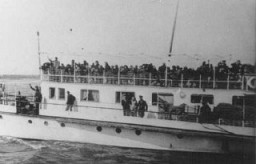
-
Thracian Jews crowded onto a ship used for deportations
PhotoThracian Jews crowded into an interior room of the Karađorđe, used as a deportation ship, just before it left the Danube River port of Lom. From Lom they were loaded onto four Bulgarian ships and taken to Vienna, where they were put on trains bound for the Treblinka killing center in occupied Poland. Lom, Bulgaria, March 1943.
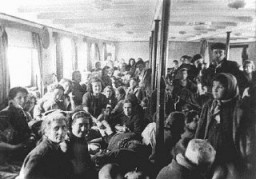
-
Three generations of a Jewish family pose for a group photograph
PhotoThree generations of a Jewish family pose for a group photograph. Vilna, 1938-39. The photo was taken during daughter Mina's visit from Montreal. Among those pictured are Mina (Katz) Herman and her daughter, Audrey (front row, second from the right), Itzik Katz, Mina's brother (standing at the far left) and Malka Katz, Mina's mother (front row, center).
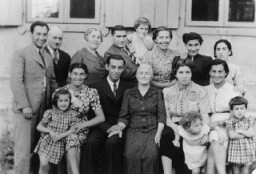
-
Three German mayors view the body of a victim of a death march
PhotoThree German mayors view the corpse of a prisoner burned alive in a barn by the SS while on a death march from Rottleberode, a subcamp of Dora-Mittelbau. Gardelegen, Germany, April 18, 1945.
